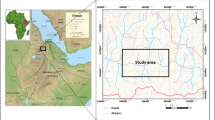Abstract
In a region that is highly sensitive to tectonic instability, the fragile nature of the Himalayas becomes further adversely affected by anthropogenic intervention. In the present study observations indicate that the landsliding process occurs along various tectonic zones where it is assisted by human activities. Bedding and joint plane dip slopes, high joint and joint set frequencies, low vegetation cover, high monsoonal rainfall, thin soil cover and anthropogenic activities were found to be the main causative factors of the landslides. Anthropogenic activities include local path, canal and road construction, mining and quarrying, overgrazing, deforestation and unscientific agricultural practices, such as tilling steeper slopes (>30∘) without contour benches and without provision of drainage ditches, and overcropping without giving rest to the overtaxed soils. Where slope conditions are critical human activities should be controlled so as to minimise the slope failure processes. Various recommendations are proposed.
Similar content being viewed by others
References
Bartarya, S.K. (1996) Landslide hazards: some case studies from the Satluj Valley, Himachal Pradesh. Himalayan Geology 17, 193–207.
Bartarya, S.K. and Valdiya, K.S. (1989) Landslides and erosion in the catchment of Gaula river, Kumaun LesserHimalaya, India. Mountain Research and Development 9(2), 405–419.
Bhandari, R.K.and Gupta, C.(1985) Problems of landslidesin the Himalaya and future directions.In Environmental Regeneration in Himalaya, Concepts and Strategies (J.S. Singh, ed.), pp. 39–57. Nainital: Gyanodaya Prakashan.
Cain, N. and Mool, P.K. (1982) Landslides in Kolpu Khola Drainage: Middle Mountains, Nepal.Mountain Research and Development 2(2), 157–173.
Haigh, M.J. (1984) Prediction and morphology of road-induced landslides inHimalaya-A case history from Central Himalaya.In Rural Development in Himalaya: Problems and Perspectives (S.C. Joshi et al., eds.), pp. 176–206. Nainital: Gyanodaya Prakashan.
Haigh, M.J., Rawat, J.S. and Bartarya, S.K. (1987) Impact of hill roads on downslope forestcover in Himalaya. Himalaya Man and Nature 11(4), 2–3.
Haigh, M.J., Rawat, J.S. and Bartarya, S.K. (1989) Environmentalindicators of landslide activity along the Kilbury Road, Nainital, Kumaun Lesser Himalaya. Mountain Research and Development 9, 25–33.
Haigh, M.J., Rawat, J.S., Bartarya, S.K. and Rawat, M.S. (1993) Factor affecting landslide morphology along new highways in the CentralHimalaya. Transactions, Japanese Geomorphological Union 14(2), 99–123.
Ives, J.D. (1982) Mapping the mountain hazards.Impacts 32(I), 79–88.
Ives, J.D. (1987) The theory of Himalayan environmental degradation: its validity and application challengedby recent research. Mountain Research and Development 7(3), 189–199.
Ives, J.D. and Messerli, B. (1981) Mountain hazard inNepal: introduction to an Applied Mountain Research Project. Mountain Research and Development 1(3-4), 223–230.
Ives, J.D. and Messerli, B. (1984) Stability and instability of mountain ecosystems: lessons learned and recommendations for the future. Mountain Research and Development 4(1), 63–71.
Jalal, D.S. (1985) Environmental degradation in Kotadun, U.P. Himalaya. In EnvironmentalRegeneration in Himalaya (J.S. Singh, ed.), pp. 421–426. Nainital: Gyanodaya Prakashan.
Johnson, K., Olson, E.A. and Mandandhar, S. (1982) Environmental knowledge and response to natural hazards in mountainous Nepal. Mountain Research and Development 2(2), 175–188.
Joshi, R.C. (1988) Quantitative geomorphic analysis of Kotadun, Kumaun Himalaya.Unpublished Ph.D. thesis,Department of Geography, Kumaun University, Nainital, 188 pp.
Kienholz, H., Schneider, G., Bischel, M., Grunder, M. and Mool, P.(1984) Mapping of mountain hazards and slope stability. Mountain Research and Development 4(3), 247–266.
Krishnaswami, V.S. and Jain, M.S. (1975) A review of some of the major landslides in northern and north western Himalaya.In Proceedingsof Seminar on Landslides and Toe Erosion Problem with Special Reference to Himalayan Region, Society of Engineering Geology, Calcutta, India.
Narayana, D.V.V. and Rambabu (1983) Estimation of soil erosion in India. Journal of Irrigation and Drainage Engineering 109(4), 409–434.
Pande, A.(1989) Quantitative geomorphic analysis of Upper Sarju Basin. Unpublished Ph.D. Thesis. Departmentof Geography, Kumaun University, Nainital, India, 307 pp.
Pande, R.K. (1992) Slope instability assessment in Karmi area of Central Himalaya,India. The Environmentalist 12(3), 211–221.
Ramsay, W.J.H. (1986) Erosion problems in Nepal Himalaya- an overview. InNepal Himalaya: Geoecological Perspectives (S.C. Joshi, ed.), Nainital: Himalaya Research Group. pp.359–395.
Tejwani, K.G.(1984) Reservoir sedimentation in India-its causes, control and future course of action. Water International 9(4), 150–154.
Valdiya, K.S. (1979) An outline of the structural setup of the Kumaun Himalaya, Journal of Geological Society of India 20, 143–157.
Valdiya, K.S. (1980) Geology of Kumaun Lesser Himalaya. Dehradun, India: The Himachal Times Press.
Valdiya, K.S. (1983)Location of landslides and hazard zoning. Report on landslides in U.P. Hills. Directorate General of Mining (GM 366/84), Lucknow, India.
Valdiya, K.S. (1985) Accelerated erosion and landslide-prone zones in the Central Himalayan Region. In Environmental Regeneration inHimalaya (J.S. Singh, ed.). Nainital, India: Gyanodaya Prakashan.
Valdiya, K.S., Joshi, D.D., Sanwal, R.S. and Tondon, S.K. (1984)Geomorphologic development across the active Main Boundary Thrust: an example from the Nainital Hills in Kumaun Himalaya. Journal of Geological Society of India 25, 761–774.
Zaruba, Q. and Mencle, V.(1969) Landslides and Their Control. Prague: Elsevier.
Zimmerman, M., Bischel, M. and Kienholz, H. (1986) Mountain hazards mapping in the Khumbu Himal., Nepal with prototype map, scale 1:50,000. Mountain Research and Development 6(1), 29–40.
Author information
Authors and Affiliations
Rights and permissions
About this article
Cite this article
Pande, A., Joshi, R. & Jalal, D. Selected landslide types in the Central Himalaya: their relation to geological structure and anthropogenic activities. The Environmentalist 22, 269–287 (2002). https://doi.org/10.1023/A:1016536013793
Issue Date:
DOI: https://doi.org/10.1023/A:1016536013793




